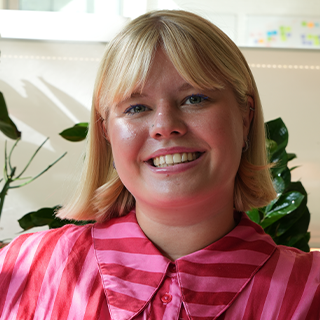Confessions of a high-end female stripper

Despite having been recognised as an official profession since the 1950s, there’s still a lot of things we don’t know about what it’s like to be a stripper. Whether it be based off of misogynistic stereotypes or unfounded criticisms of the sex work industry, strippers’ identities, thoughts and feelings about their own work has been repeatedly pushed to the side or ignored.
What seems to keep happening is that rather than listen to those who’re actually stripping for a living, we rely on the discourse and opinion of a society whose attitudes are defined by media stereotypes and outdated modes of thinking to make up our minds on the profession. And, historically, society has always been unkind to women who break tradition.
One club set on rebalancing the power dynamics of the stripping industry is 23 Paul Street. Nestled in a leafy corner of Shoreditch, London, 23 Paul Street is a “townhouse of tease” which acts as a stunning backdrop to sex work done right. The club is female-led, and its number one priority is protecting the safety of its employees. Respect, boundaries, and rules are at the forefront of the club’s ethos.
There are so many misconceptions about strippers—for starters, sex work does not simply translate to someone who gets paid to have sex with people. Moreover, there’s often immediate presumptions about strippers’ personalities, interests and, most importantly, the reasons why they strip in the first place.
So, to try and gain a greater perspective on the industry, SCREENSHOT spoke with 27-year-old Skyla, a stripper who’s been 23 Paul Street for five months, and in the industry since she was 19.
How did you first become a stripper?
Having “always loved dancing,” Skyla knew from a young age that she wanted to be involved in the entertainment industry. And then, when she turned 19, she spent the summer stripping with her best friend in order to fund their holidays in the sun. For Skyla, her first day in a strip club still feels like it was yesterday.
“I was so nervous, I have no idea how I got through it. I went to this little rundown club in my TK Maxx maxi dress (because you had to wear long dresses back then), stumbled around this pole and somehow got the job and it just then funded my lifestyle of having a really good time that summer,” Skyla recalled.
From there, she began working in different small clubs in East London, going from “low-end” venues to slightly bigger “tourist attraction ones.” Skyla noted how, as the years have gone on, she’s tried other forms of sex work such as Babestation and OnlyFans, but has always preferred the “personal touch, where you’re face to face with people.”
“I like the interaction with people, it’s one of the main reasons I keep coming back to it,” she continued.
How does 23 Paul Street differ from other strip clubs?
As made evidently clear from the company’s website, 23 Paul Street is a rule-oriented environment, one where women run the show. Skyla shared: “It’s such an empowering club. I’ve never worked somewhere that is all-female run and not only female run, some of the managers have been strippers before. They understand what we’re going through and when we have our bad nights, they know the rules to put in place to keep us safe and to keep us [together] as a team.”
Having management that not only prioritises the safety and well-being of their employees, but can also directly relate to their day-to-day experiences and interactions, completely changes the energy of the environment and creates a space where dancers feel empowered rather than disrespected.
On top of this, Skyla emphasised the ways in which the management style and make-up can impact the performers’ dynamics as well. She noted how “there’s a lot of clubs where it is so catty because everyone has to fend for themselves,” whereas with 23 Paul Street being female-led, the hierarchy is completely different. The entertainer joked: “Men who run strip clubs are on a power trip, and they’re all assholes, I’ve decided.”
Is it predominantly men who visit the strip club?
It’s definitely always been assumed that men are far more likely to visit a strip club than women are. And while that’s definitely not always the case, Skyla did reveal that she interacts with solo male customers much more often than she does solo women. However, she did also state that 23 Paul Street regularly has couples who visit together, predominantly to explore and try something new in their relationship.
While women have been at the forefront of sexual pleasure, it’s historically been for the benefit of men—almost as if we’re props for their own personal enjoyment. Skyla did express how she’s previously worked at a few different events which have been geared towards lesbians and bisexual women, and that she’d definitely like for there to be a more balanced gender split.
While platforms like OnlyFans have helped de-centralise the sex work industry and allow for more women to not only become involved as earners, but also as viewers, it’s definitely still the case that when it comes to in-person strip clubs, men are the dominant clientele.
What’s been your worst experience as a stripper?
While our chat focused primarily on the ways in which stripping as a profession has been historically misunderstood, I did think it was also important to showcase some of the ways in which Skyla has experienced abuse of power and intimidation within the industry.
When asked about her worst experience as a stripper, Skyla divulged that when she first started out, she was working in a club, and during her second or third shift, the “house mum” (aka, an informal manager of sorts for the dancers) took her and another dancer aside and said: “Just so you know, when you’ve finished giving any blowjobs, just make sure that you tip the bouncer.”
Skyla was understandably completely taken aback by the comment. She continued, explaining: “I just thought to myself ‘I’m never going to make money here’.” Following this, Skyla was confronted by a customer who, after she had given him a dance, demanded something more, complaining that he’d been given a “five knuckle shuffle” previously, and insisting Skyla find a girl who’d take her place. That was the moment when she decided to never go back to that club.
What’s the biggest misconception society has about being a stripper?
One of the most important points I wanted to touch upon with Skyla was how she felt regarding stereotypes and misconceptions surrounding both being a stripper, and the stripping industry as a whole.
Beginning to laugh, Skyla confessed: “My favourite one is when someone says ‘Oh, you know what, someone’s gonna really care for you one day’. I have a husband at home that loves me, so it’s very condescending to hear from a stranger ‘Oh somebody will love you one day’.”
It’s a massive misconception that in order to be a stripper, someone must be automatically single, alone, and in need of a man to swoop in and save them—this just is not the case. Of course, there are cases of sexual and emotional exploitation within the sex work industry, but it’s irresponsible and plain wrong to assume this is the default.
Judgement will always exist in the sex work industry, which is why it’s so important to get more testimonials from the people who actually navigate that world every day.
Moreover, as previously mentioned, sex work is not one thing, there are individuals who participate in so many different facets of the industry and it’s incredibly offensive to bundle everyone all together.
Skyla noted: “We’re just normal people at the end of the day. I guess it’s better now because it is more talked about, but you still get people that do make judgments. If they get to know you, you’re just doing what you need to do, sometimes you don’t even take your pants off!”
“It would be nice for people to realise that actually, we’re just normal people and we’re going to go home at the end of the night. You might have another day job and some people may have kids to go back to, it’s just a job. It’s the oldest job in the book and we’re just using what we’ve got to do it,” the dancer concluded.
What’s the best thing about being a stripper?
For Skyla, her time as a professional stripper has allowed her to make “the most amazing friends. I’ve still got friends from nine years ago when I started in my first ever club. I actually recently got one of them a job at 23 Paul Street, so that’s been amazing.”
Skyla continued: “I’ve also had some amazing experiences. One night at 23 Paul Street, before I’d even started working there, one of the managers invited me over for this ‘pecking order’ night. It was all about empowering women and using the men as coffee tables and things like that.”
It was at that event that Skyla met this group of guys who subsequently took her and a few other dancers to Thailand, Nikki Beach and on a number of other incredible trips.
“I’m potentially never going to be able to do that again. And that’s all thanks to the people that I’ve met through stripping, because it’s not about sex. Sometimes, people just want friendship and to go enjoy some time outside of the club.”
When might you want to stop stripping?
The last thing I wanted to ask Skyla was when she might consider taking a step back from the stripping industry. Almost immediately after I posed the question to her, she jumped in and exclaimed “until it’s not fun anymore.”
Of course, she recognises that “you can overdo it” but, as long as someone is “getting enough sleep and doing it because they want to, not because they have to,” then Skyla doesn’t see why there needs to be a cut-off point.
For the 23 Paul Street dancer, she’s never wanted to strip solely for the money, it’s always been so much more than that. Skyla rounded up our chat by explaining: “I genuinely enjoy my time here, and of course I like being able to get paid well. That’s the beauty of it. When you’re not seeking it out, you always have a great night with great people and just meet individuals from all different walks of life as well.”





